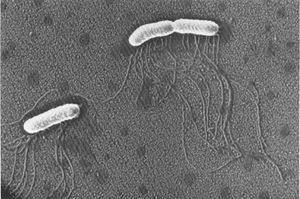User:Alexandra.williams
Pectinatus cerevisiiphilus
Classification
Higher order taxa
Domain: Bacteria
Phylum: Firmicutes
Class: Negativicutes
Order: Selenomonadales
Family: Veillonellaceae
Genus: Pectinatus
Species: cerevisiiphilus (Skerman et al., 1989)
Species: NCBI:Taxonomy(http://www.ncbi.nlm.nih.gov/Taxonomy/Browser/wwwtax.cgi?mode=Info&id=86956)
Pectinatus cerevisiiphilus
Description and significance
In the late 1970’s new filling techniques in distilleries led to some beer spoilage due to new bacteria. In 1978, Pectinatus cerevisiiphilus, was first described by Lee, Mabee, and Jangaard as an anaerobic, rod-shaped bacterium with unusual arrangement of flagella (Lee et al., 1978). Early studies classified this bacterium as Gram-negative (Jespersen and Jakobsen, 1996). Later studies classified P. cerevisiiphilus as a Gram-positive bacterium based on genomics (Helander et al., 2004). The most notable function of P. cerevisiiphilus is the by-products it creates that cause spoilage in beer. These by-products include hydrogen sulfide, acetic acid, and propionic acid which cause the foul taste in exposed beer (Chodhury et al., 1997)
Genome structure
The gene for 16s ribosomal RNA of P. cerevisiiphilus is 1547 base pairs arranged as linear DNA. There are between 424 and 446 amino acid protein encoding genes (Skerman et al., 1989). The G+C content of P. cerevisiiphilus DNA is 38-41% (Scheifer et al., 1990).
Cell structure and metabolism
P. cerevisiiphilus are anaerobic bacteria that have an odd outer membrane (OM) along with the presence of lipopolysaccharides (LPS) that cause it to look and test Gram-negative. However, it has recently been determined that the cell envelope contains a thick peptidoglycan layer common of gram-positive bacteria. The OM in recent studies has proven to be an ineffective, highly permeable barrier and the peptidoglycan layer is much more protective. These discoveries led to the recent reclassification as gram-positive (Helander et al., 2004). P. cerevisiiphilus are rod shaped bacteria that have 10 to 23 flagella located on only one side. They tend to be 0.7 to 0.8 µm by 2.0 to 32 µm though older cells may get longer (Lee et al., 1978). Mature cells often obtain a helical shape. P. cerevisiiphilus was first discovered in 1978 as a result of improved filling techniques that allowed the beer less exposure to oxygen providing more favorable conditions for anaerobes (Helander et al., 2004). P. cerevisiiphilus causes unpleasant off-flavors due to its by products; hydrogen sulfide, acetic acid, and propionic acid. A cell concentration of 106 cells/mL is considered undrinkable. In 1981, contamination rate was at 1%. In 1987, it had risen to 7% and it is still rising today due to its high adaptability (Chowdhury et al., 1995).
Ecology
P. cerevisiiphilus are part of a larger group known as beer spoilage bacteria because they are commonly found in packaged beer. Their ability to grow in pH levels of 4.0-6.4 and temperatures from 8-39 degrees Celsius (Flahaut et al., 2000) and survive even wider ranges, allow them to persist at every stage of the brewing process. They are strictly anaerobes, however they can withstand some oxygen for hours at a time, this time period increase with the presence of brewer’s yeast (S. cerevisiae) and lower temperatures (Chowdhury, 1995). P. cerevisiiphilus can also be found all throughout contaminated breweries proving to be a permanent inhabitant rather than an occasional invader of such places (Helander et al., 2004).
References
1. Chowdhury, I, Watier, D., Leguerinel, I., & Hornez, J.-P. (1997). Effect of Pectinatus cerevisiiphilus on Saccharomyces cerevisiae Concerning its Growth and Alcohol Production in Wort Medium. Food Microbiology, 14(3), 265–272. doi:10.1006/fmic.1996.0092
2. Chowdhury, Iffat, Watier, D., & Hornez, J.-P. (1995). Variability in Survival of Pectinatus cerevisiiphilus, Strictly Anaerobic Bacteria, Under Different Oxygen Conditions. Anaerobe, 1(3), 151–156. doi:10.1006/anae.1995.1012
3. Flahaut, S., Tierny, Y., Watier, D., Hornez, J.-P., & Jeanfils, J. (2000). Impact of Thermal Variations on Biochemical and Physiological Traits in Pectinatus sp. International Journal of Food Microbiology, 55(1–3), 53–61. doi:10.1016/S0168-1605(00)00194-X
4. Helander, I. M., Haikara, A., Sadovskaya, I., Vinogradov, E., & Salkinoja-Salonen, M. S. (2004). Lipopolysaccharides of Anaerobic Beer Spoilage Bacteria of the Genus Pectinatus – lipopolysaccharides of a Gram-positive genus. FEMS Microbiology Reviews, 28(5), 543–552. doi:10.1016/j.femsre.2004.05.001
5. Jespersen, L., & Jakobsen, M. (1996). Specific Spoilage Organisms in Breweries and Laboratory Media for their Detection. International Journal of Food Microbiology, 33(1), 139–155. doi:10.1016/0168-1605(96)01154-3
6. Lee, S. Y., Mabee, M. S., & Jangaard, N. O. (1978). Pectinatus, a New Genus of the Family Bacteroidaceae. International Journal of Systematic Bacteriology, 28(4), 582–594. doi:10.1099/00207713-28-4-582
7. Schleifer, K. H., Leuteritz, M., Weiss, N., Ludwig, W., Kirchhof, G., & Seidel-Rüfer, H. (1990). Taxonomic Study of Anaerobic, Gram-Negative, Rod-Shaped Bacteria from Breweries: Emended Description of Pectinatus cerevisiiphilus and Description of Pectinatus frisingensis sp. nov., Selenomonas lacticifex sp. nov., Zymophilus raffinosivorans gen. nov., sp. nov., and Zymophilus paucivorans sp. nov. International Journal of Systematic Bacteriology, 40(1), 19–27. doi:10.1099/00207713-40-1-19
8. Skerman, V., McGowan, V., & Sneath, P. (Eds.). (1989). Approved Lists of Bacterial Names (Amended). Washington (DC): ASM Press. Retrieved from http://www.ncbi.nlm.nih.gov/books/NBK814/

